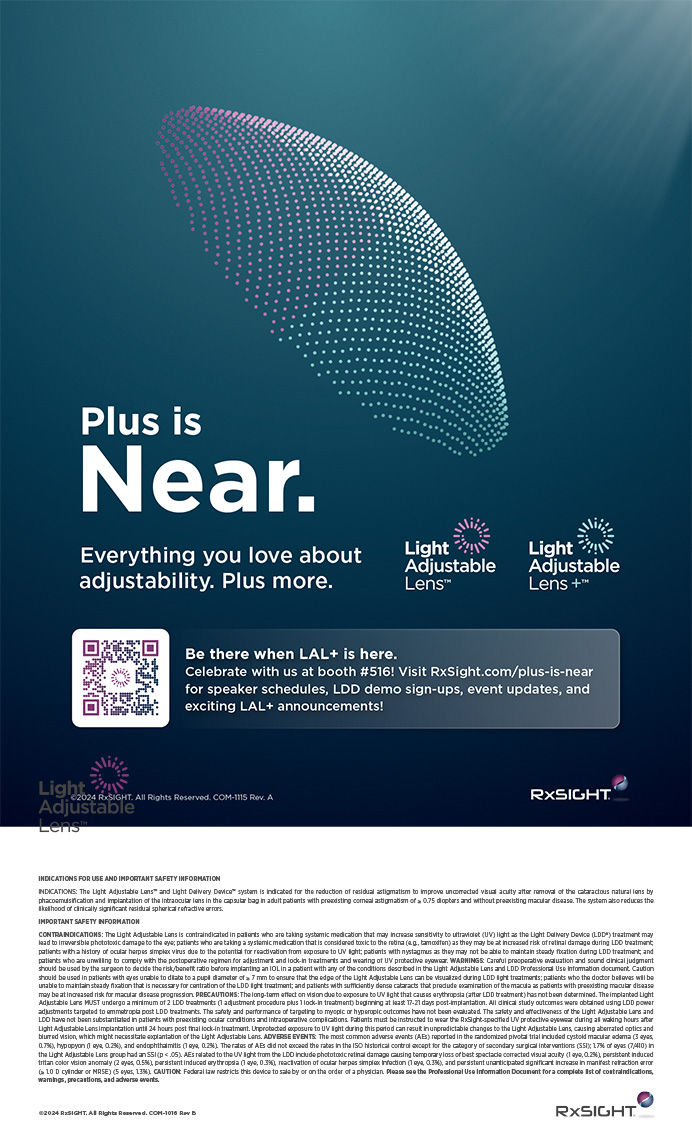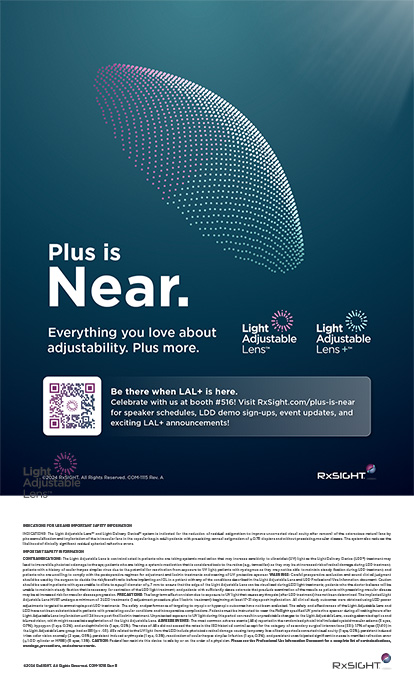The last few years have brought tremendous innovations to the IOL technology available to ophthalmologists. Advances include small power steps in torics, presbyopia-correcting multifocals, IOLs that block specific wavelengths of light, and, most recently, sophisticated aspheric IOLs that counter the naturally occurring positive spherical aberration of the anterior cornea.
Of the new-technology aspheric IOLs, I prefer the Acrysof IQ lens (Alcon Laboratories, Inc., Forth Worth, TX) for several reasons.
THE REASONS FOR MY PREFERENCE
The Acrysof IQ lens (Figure 1) comes on the proven platform of the Acrysof Natural lens (Alcon Laboratories, Inc.). Surgeons used to implanting the single-piece acrylic IOL face no learning curve when transitioning to aspheric technology. With a similar edge design and the same high-index acrylic material as the original Acrysof IOLs, the Acrysof IQ lens has a remarkably low rate of posterior capsular opacification. Additionally, the slow and controlled unfolding of this lens during its implantation makes it ideal for eyes with small compromises in the capsular bag such as a limited central defect.
In addition, the optic of the new Acrysof IQ lens is very thin, noticeably so when compared with other aspheric IOLs. It is more than 9 thinner than the regular Acrysof single-piece and Natural platforms, which makes it possible to implant the Acrysof IQ lens through incisions smaller than 2.5mm. As advances in phaco technology allow surgeons to use smaller and smaller corneal incisions, it will not be necessary to change to a different IOL.
The optic of the Acrysof IQ lens is aspheric. With traditional, spherical IOLs, image quality degrades toward the optic?s periphery, because the marginal rays are brought into focus in front of the central rays. The human cornea shares this property, known as positive spherical aberration. In the pseudophakic state, the combination of a traditional spherical IOL and the naturally occurring positive spherical aberration of the cornea increases the total amount of spherical aberration. With a spherical IOL, as the size of the pupil increases, a reduction in contrast sensitivity occurs. An aspheric IOL does not add positive spherical aberration to the optical system.
The most advanced feature of the aspheric optic of the Acrysof IQ lens is that it also provides 0.20µm of negative spherical aberration. With larger pupils, this correction enhances image quality by counteracting the remaining positive spherical aberration of the cornea. Understanding the corrective strategy behind the Acrysof IQ lens helps to explain why the addition of 0.20µm of negative spherical aberration is an excellent choice for most cataract surgery patients.
COMPENSATORY STRATEGY: THE YOUTHFUL EYE
The Acrysof IQ lens is designed to function much like the youthful crystalline lens by counteracting the naturally occurring positive spherical aberration of the anterior cornea such that the final amount of residual positive spherical aberration approximates that of the youthful eye. The negative spherical aberration of the youthful crystalline lens is typically less than the positive spherical aberration of the anterior cornea. Studies have shown that this value commonly ranges between -0.138 and -0.24µm for young eyes.1-3
Beiko4 found that the positive spherical aberration of the human cornea follows a normal distribution, with a mean value of approximately 0.275µm. Other studies have shown a similar value, and this amount appears to change very little with age5,6 (Figures 2 and 3).
If the mean positive spherical aberration value of the cornea is 0.275µm and the negative spherical aberration value of the young crystalline lens is somewhere between -0.138 and -0.24µm, then the net result is a small amount of naturally occurring positive spherical aberration. It is interesting that this value is often symmetrical.7
On the optical bench, image quality would normally be the best if all higher-order aberrations were corrected down to zero. Intuitively, one would expect that correcting all spherical aberration for the human eye would also produce the best visual performance. The clinical literature suggests otherwise. A small amount of positive spherical aberration may be the optimal choice for human vision.3,4,8-12
A comprehensive clinical study by Beiko4 compared the visual performance of two groups of several hundred matched patients with the Tecnis lens (Advanced Medical Optics, Inc., Santa Ana, CA): one with zero mean residual spherical aberration of the whole eye for a 6-mm pupil and another with positive 0.1µm of residual spherical aberration for the same pupillary size. Beiko found that targeting a residual positive spherical aberration of 0.1fµm following cataract surgery resulted in superior visual performance. He also demonstrated that eyes implanted with the Acrysof IQ lens with an average of 0.1µm of positive residual spherical aberration achieved higher contrast sensitivity when compared to eyes implanted with the Tecnis lens that had no residual positive spherical aberration. Similarly, Legras et al8 found that, for a 6-mm pupil, the optimal value for spherical aberration was not zero but 0.08µm. These findings are the reason the targeted value of spherical aberration for the Acrysof IQ lens for the average pseudophakic eye is approximately 0.1µm ( 0.075µm).
At present, three aspheric IOLs are available in North America. For a 6-mm pupil, the Tecnis lens adds 0.275µm of negative spherical aberration, the Acrysof IQ lens adds 0.20µm of negative spherical aberration, and the Sofport AO IOL (Bausch & Lomb, Rochester, NY) adds none. I use a 6-mm pupillary size, because it is an accepted industry standard for the design considerations with aspheric optics and ocular aberrometry methods for diagnostic purposes.
In an ideal world, surgeons would measure the amount of anterior corneal spherical aberration for each patient prior to cataract surgery and match this value to an IOL with the optimal correction for this higher-order aberration. In the real world, the expense of using such technology currently makes such an exercise impractical.
What I like about the Acrysof IQ lens is that the smallest number of patients will be over- or undercorrected with 0.20µm of negative spherical aberration added to their pseudophakic optical system. With the Sofport AO lens, almost every patient will be undercorrected, whereas somewhat less than half will be overcorrected with the Tecnis.
It is helpful to remember that, in the presence of small pupils, the Acrysof IQ, Tecnis, Sofport AO, and any spherical IOL all perform about the same in terms of contrast sensitivity. With small pupils, moreover, I doubt that anyone could tell a difference. With pupils of 4mm or larger, however, the correction of anterior corneal spherical aberration begins to make a difference in both image quality and visual performance, as shown by contrast sensitivity testing.13 Again, the ideal would be to match the IOL with the measured anterior corneal spherical aberration (this is different than the whole eye wavefront) of the individual patient for a 6-mm pupil and to leave approximately 0.1µm of residual positive spherical aberration.
As part of the IOL power calculation process in my office, we now measure the anterior corneal spherical aberration of each patient prior to cataract surgery. At this stage in the development of this emerging technology, all surgeons really need to know is whether or not the 6-mm anterior corneal Z(4,0) value is low, medium, or high. They may then select the best corresponding IOL. The Sofport AO lens and the SN60AT lens (Alcon Laboratories, Inc.) would work best with low values, the Acrysof IQ IOL would be a good choice with medium values, and the Tecnis lens gives optimal results for high values. For the majority of my patients, the Acrysof IQ lens ends up being the most suitable.
CONCLUSION
With each year, the line that separates cataract from refractive surgery fades further. Many of my patients who have received the new Acrysof IQ lens tell me their uncorrected vision is the best that it has been since they were teenagers. The goal of aspheric IOLs with negative spherical aberration is the approximation of a Z(4,0) value of the youthful eye. Such comments from patients confirm that lens technology is on the right track.
Warren E. Hill, MD, is in private practice in Mesa, Arizona. He is a consultant to Alcon Laboratories, Inc., but he stated that he holds no financial interest in the products mentioned herein. Dr. Hill may be reached at (480) 981-6111; hill@doctor-hill.com.


